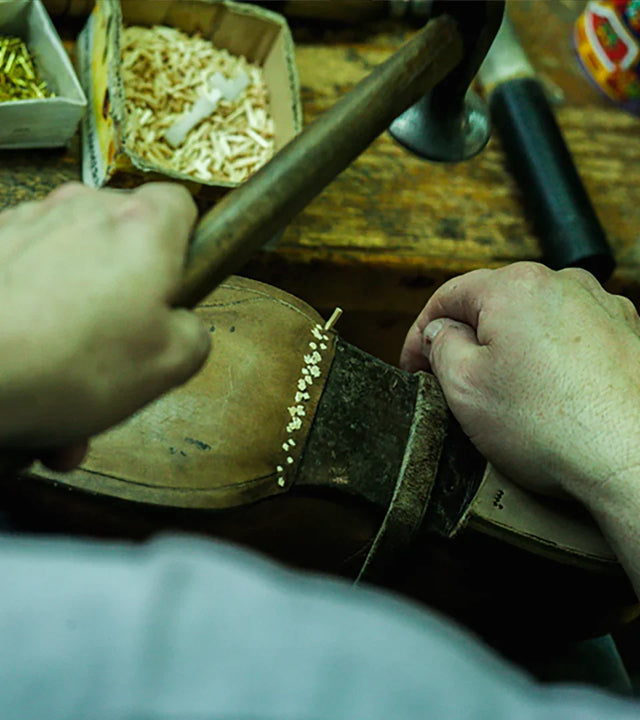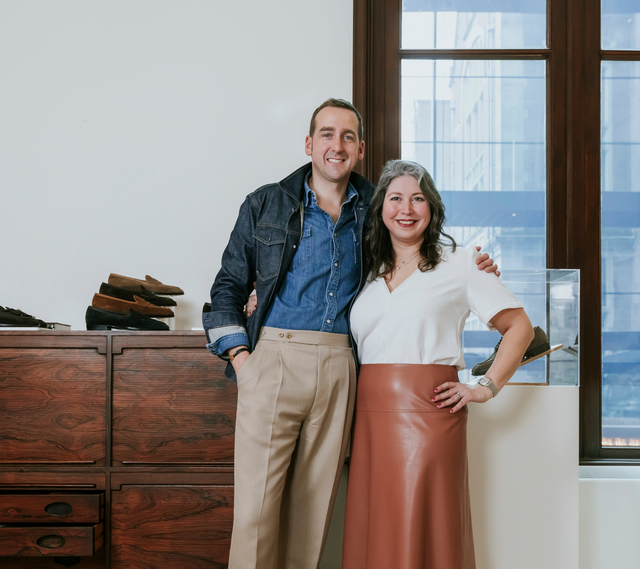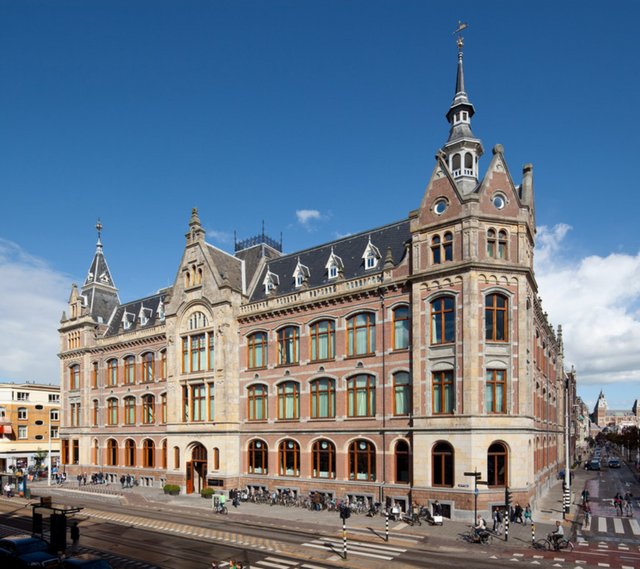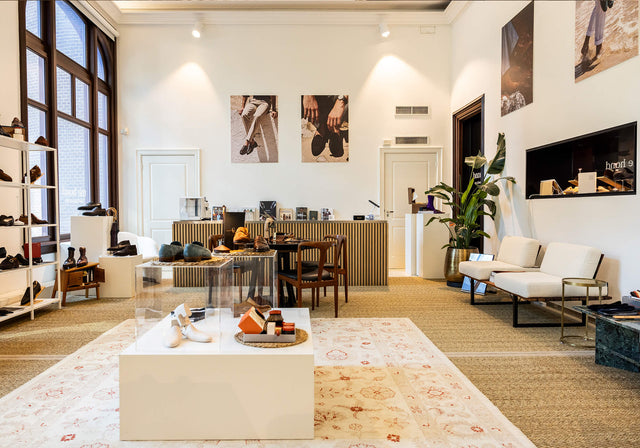Introducing: Saint Crispin’s
We’re extremely excited to announce that Saint Crispin's has joined our stable of the world’s finest shoemakers. It was only a matter of time, too, as the Austro-Romanian shoemaker has not only a unique design language that’s executed to remarkable standards but an irresistible value-for-money proposition. In this Journal article, we speak with Saint Crispin’s owner, Phillip Carr.
Phillip Carr speaks candidly and honestly about his highly regarded shoemaking company, which takes its name from the Christian patron saints of cobblers, curriers, tanners, and leather workers. “One of our main goals is that people get compliments,” he says. And, if the rapturous reviews online and first-hand experiences of Dennis are anything to go by, it’s completely plausible that an owner of a pair of Saint Crispin's shoes would receive a positive compliment given that he is wearing something akin to a wearable work of art.
Though the company was founded in 1992, Saint Crispin's was a purely bespoke shoemaker until Phillip joined the business in 2003, and, in the space of two decades, he has guided the company into the position of being, without a doubt, an industry leader.
One of the things that makes Saint Crispin's unique is that unlike your traditional shoemakers – say, those from the likes of Northampton, Paris and Florence – it operates a MTO business model. “We, as a business, come from bespoke, so in the workshop, we have benches and not conveyor belts or anything. We are much smaller and, I guess, more inventive. We don't have different lines, which take different lengths of time and differing priorities. We only make 1,500 pairs a year, and they're all on the same level,” he says.
As a result of this streamlined model with zero complexities, Saint Crispin's can make a pair of MTO shoes in six to eight weeks. “We have an express option which takes four weeks with a surge charge,” he adds. In this world where we have anything and everything we could want at the click of a button, a pair of handmade shoes is unheard of in such a short time.
Though the company is Hungarian in blood and spirit, the workshop is based in the Transylvanian city of Brasov, Romania. Within the walls of an unassuming building are 28 people in total, 22 of which are craftspeople. Its location is not due to financial advantages but simply where the skills are best, and the workforce has plenty more to give to the art of shoemaking, as the average age is considerably younger than in other nations. “The reason why shoemakers are younger – let’s say 40 to 50 – is because up until the 1980s in Romania, they made their military boots entirely by hand. Even for Russia, in fact. So, whilst everything was becoming very industrialised in other countries, in Romania, there were still schools where you learned to make shoes by hand,” Phillip explains.
 So what of the levels of craftsmanship hailing from Brasov? In short, they are supreme and rival bespoke, with at least 95% of the entire production being carried out by the hands of the 22 artisans. “Our shoemakers concentrate only on the finish, on the stitching, on the welting,” Phillip states. As for the balance of 5%, that accounts for the old, hand-driven wheel machine that’s used (with difficulty) to attach the sole. Phillip could have easily glossed over this one machine-made area, but his honesty only further underlines the exquisite level of craftsmanship imbued in his creations.
So what of the levels of craftsmanship hailing from Brasov? In short, they are supreme and rival bespoke, with at least 95% of the entire production being carried out by the hands of the 22 artisans. “Our shoemakers concentrate only on the finish, on the stitching, on the welting,” Phillip states. As for the balance of 5%, that accounts for the old, hand-driven wheel machine that’s used (with difficulty) to attach the sole. Phillip could have easily glossed over this one machine-made area, but his honesty only further underlines the exquisite level of craftsmanship imbued in his creations.
Regarding everything else, which encompasses tasks such as crafting the lasts, stitching the uppers, welting, pegging the waists, hollowing the shoe trees, and even creating the shoe bags and laces, all of these processes are carried out manually. "We are wholeheartedly committed to this manual craftsmanship, although I am also aware that this may not remain sustainable indefinitely," he further explains.
Another string to Saint Crispin's bow is that it often sources natural crust leather, as opposed to coloured hides from the various tanneries it works with. In doing so, the team cuts the pattern and then individually dyes them to the desired colour. This is a laborious process, but the results are unique, and your shoes develop a patina quicker than they would otherwise.
As for the house style of Saint Crispin's, Phillip says that he “wouldn't consider our house style to be that of the Hungarian or Romanian styles, due to their elegance, so they're something like the best of the worlds of the French, Italian and English.” The company has a predilection for traditional colours but with character and substance – think hatch grain, Russian calf, ‘shrunken calf’ and plenty of gorgeous suedes – with discerning points of interest such as intricate broguing and more.
 To launch Saint Crispin's on The Hand, Dennis and Phillip have knocked their heads together and have created seven exclusive styles. There are two types of suede Chukka boots, one with a Novegese welt. Additionally, two types of loafer, a tassel and a penny. The latter in dark espresso, “serves every condition, from white jeans to a navy pinstripe suit,” says Phillip. There’s then a double-buckle, Oxford wingtip and a Blutcher Derby, all perfect reflections of Saint Crispin's unique design language, Savoir-faire and The Hand’s love for timeless and versatile men’s shoes.
To launch Saint Crispin's on The Hand, Dennis and Phillip have knocked their heads together and have created seven exclusive styles. There are two types of suede Chukka boots, one with a Novegese welt. Additionally, two types of loafer, a tassel and a penny. The latter in dark espresso, “serves every condition, from white jeans to a navy pinstripe suit,” says Phillip. There’s then a double-buckle, Oxford wingtip and a Blutcher Derby, all perfect reflections of Saint Crispin's unique design language, Savoir-faire and The Hand’s love for timeless and versatile men’s shoes.
We’re pleased to announce that Saint Crispin’s will be in Amsterdam for its debut trunk show with The Hand from Friday, November 10th and Saturday, November 11th 2023. To register your interest and make an appointment, please contact us by emailing hello@meetthehand.com. We look forward to seeing you.






